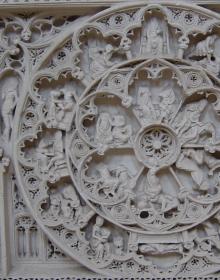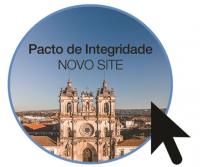- HOME
- MONUMENT
- VISIT OUR MONUMENT
- HERITAGE LEARNING
- ALCOBAÇA
- MONASTERIRES ROUTE

Monastery of Alcobaça
National Monument

Alcobaça Monastery, classified as a National Monument by Decrees DG no. 14 of 10.01.1907 and DG no 136 of 16.06.1910; and as a special protection zone by Decree DG (2nd Series) no. 190 of 16.08.1957. (...)
Click here to find out more
World Heritage

Alcobaça Monastery has been inscribed in the UNESCO World Heritage Site since December 1989 (13th Session of the World Heritage Committee held in Paris). This process was initiated by a proposal from ICOMOS in April 1989 on the basis of inscription (...)
Click here to find out more
Space and Time

The Abbey of Santa Maria de Alcobaça was established while Portugal was still a fledgling Kingdom and soon became one of the most important and most influential Cistercian centres in the whole of the Iberian Peninsula. It was founded in 1153 by the first (...)
Click here to find out more
The Monastery Complex

The complex of Alcobaça Monastery is one of the most notable and best conserved examples of Cistercian architecture and spatial philosophy. (...)
Click here to find out more
Church

Consecrated in 1252, the Monastery church was the first Portuguese Gothic religious building. Its large scale and remarkable elegance of proportions make it a consummate example of the contrasting effect of stone and light. (...)
Click here to find out more
King Dinis Cloister
The nerve centre of the whole Monastery and obligatory stop on the way to all the monastery rooms, the Cloister was also a place for reading and meditation. (...)
Click here to find out more
Tomb of King Pedro

The decoration on the tomb of Pedro I consists mainly of Gothic relief sculpture work depicting scenes from the life of Saint Bartholomew. (...)
Click here to find out more
Tomb of Inês de Castro

The tomb of Inês de Castro rests on six hybrid figures with human faces the bodies of beasts. (...)
Click here to find out more
Reliquary Chapel

Built into the New Sacristy, this chapel of supreme beauty and spirituality – dubbed the “Mirror of Heaven” by Reynaldo dos Santos – was built between 1669 and 1672 under the Abbot Constantino de Sampaio. (...)
Click here to find out more
Kitchen
For obvious functional reasons, the mediaeval kitchen was located next to the Refectory. It was destroyed in the 17th century, when the Afonso VI Cloister was built and only its Romanic door remains. (...)
Click here to find out more
Refectory

Located next to kitchen, the Refectory is an impressive space thanks to its dimensions, meticulous architecture and structural complexity. (...)
Click here to find out more
Desterro Chapel

A small, elegant rectangular building from the 18th century, the Desterro Chapel presents a typically Baroque retable façade featuring a portal flanked by four Solomonic columns on top of which is a pediment with an oculus in the centre. This group is (...)
Click here to find out more
Gallery

The south wing of the Monastery, which housed the College of Our Lady of the Conception and the quarters of the abbots of the Autonomous Congregation and which was also were the Municipal Library was housed, underwent a profound intervention in the late (...)
Click here to find out more
SERVICES - ACTIVITIES




